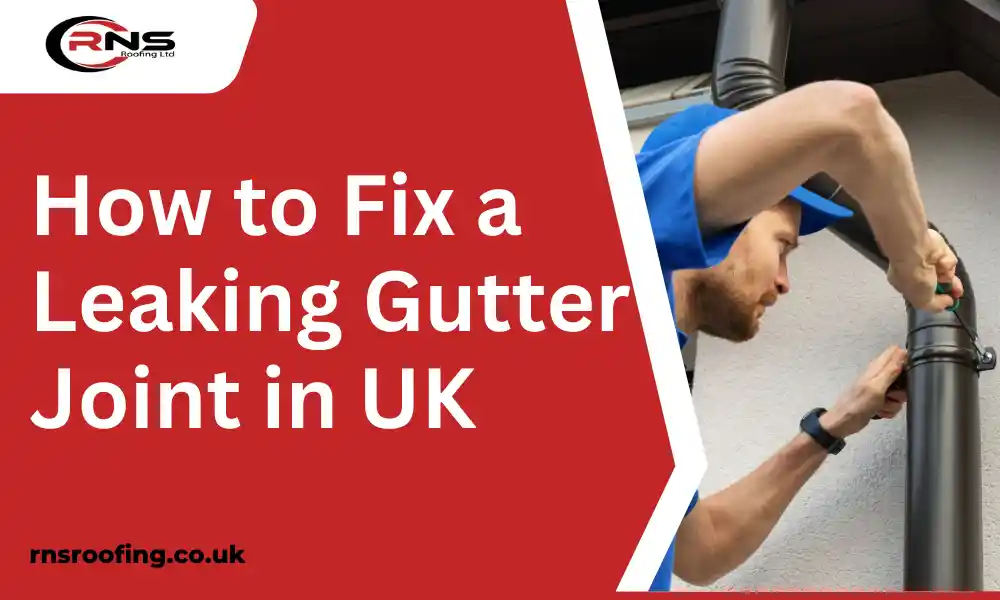Leaking gutter joints can cause severe problems if left unchecked, leading to water damage and potential dampness in your home. Luckily, fixing a leaking gutter joint is a quick and easy task that you can tackle yourself. Follow this guide to get your gutter back in shape.
How to Fix a Leaking Gutter Joint
1. Identify the Cause of the Leak
Before you start, inspect the gutter to find the exact cause of the leak. Fixing a leaking gutter joint occurs due to:
- Blockages in the Gutter System
- Rubber Seal is Missing
- Wear and Tear Caused By The Weather Over Time
- Weakness and Deformation Caused By Heat Changes
Blockages in the Gutter System
Regular inspections of a gutter system are necessary to ensure there are no blockages. Debris can accumulate, especially after a storm or if birds roost on your rooftop. Organic matter, such as moss, lichen, and other plant life, can grow within a guttering system that has not been cleaned for some time. When a gutter system becomes blocked, rainwater can overflow and run down the side of the building or across lower roof areas.
Rubber Seal is Missing
Whether the Leaking gutter joint was installed without the rubber seal or if it has corroded over time, this missing item can lead to leaks. Guttering needs to be sealed to ensure its integrity. A purpose-designed gutter treatment system will provide resilience and long-term protection.
Wear and Tear Caused By The Weather Over Time
Guttering endures a lot of wear and tear due to constant exposure to the elements and the vagaries of the British weather. Over time, extreme conditions, such as ice, snow, heavy rain, and heat waves, all take their toll on a guttering system.
Weakness and Deformation Caused By Heat Changes
Hot and cold temperatures have an adverse effect on gutter components. Heat can cause expansion, while icy weather can cause the gutter to contract. This places a strain on the gutter and its protective coating and causes gaps between the seals and joints.
2. Clean the Gutter
To ensure a proper fix, the gutter must be clean and debris-free.
- Use a ladder to reach the gutter safely
- Remove any leaves, dirt, or debris with a small trowel or your hands
- Flush the gutter with water to check if the leak persists
3. Reseal the Gutter Joint
Once the gutter is clean, it’s time to fix the leak by resealing the joint.
- Remove Old Sealant:
If there’s an existing sealant, gently scrape it away with a putty knife.
- Apply Fresh Sealant:
Use a high-quality gutter sealant or silicone to reseal the joint. Apply an even layer around the edges of the gutter leaking joint, covering the entire area.
- Smooth It Out:
Use a damp cloth or finger to smooth the sealant and ensure a tight seal.
Let the sealant dry completely as per the manufacturer’s instructions. Repairing gutter leaks is essential to prevent water damage and maintain the overall health of your home’s exterior.
4. Tighten the Gutter Joint
If the joint is loose or misaligned, you’ll need to tighten or adjust it.
- Check the Clips or Brackets:
Ensure the clips holding the gutter sections together are secure.
- Reposition the Joint:
If necessary, gently move the gutter sections to align them properly.
- Tighten Screws or Clips:
Use a screwdriver to secure any loose screws or clips holding the gutter in place.
5. Test the Repair
Once the sealant has dried and the joint is tightened, it’s time to test the repair.
- Use a hosepipe to pour water into the gutter
- Check the joint to see if there are any leaks
If the joint is watertight, the repair has been successful. Properly repairing leaking gutter joints is essential to prevent water damage and maintain the structural integrity of your home.
6. Prevent Future Leaks
Regular maintenance is essential to avoid future gutter joint leaks.
- Clean the Gutters Regularly:
Clear out debris at least twice yearly, especially after heavy rainfall or autumn leaves.
- Check the Joints:
Inspect the gutter joints for signs of wear and tear, and reseal or tighten as necessary.
- Ensure Proper Drainage:
Make sure downpipes are clear and water is flowing freely.
Conclusion:
Repairing a leaking gutter joint is an easy DIY task that can prevent more significant problems. By following these steps, you can ensure your gutter works efficiently, keeping your home protected from water damage. Consulting with a professional roofer is always recommended if you’re unsure about the repair process or encounter significant difficulties.
FAQs
1. Should you use silicone on gutter joints?
We avoid silicone as it’s prone to bird attacks and deteriorates quickly. First, check whether you need to replace the gutter joint or whether you can seal and treat the guttering while in situ.
2. How often should I check my gutter joints for leaks?
Inspecting your gutter joints twice a year, particularly in the autumn and spring and after heavy rainfall or storms, is advisable. Regular maintenance helps catch minor issues before they turn into more significant problems.
3. What’s the best way to prevent gutter joints from leaking in the future?
Regular cleaning and maintenance are essential. Ensure your gutters are debris-free, inspect the joints for wear, and reseal or tighten them as needed. Also, keep downpipes clear to ensure proper drainage.
4. Do I need special tools to fix a leaking gutter joint?
No special tools are required. You’ll need a ladder, a screwdriver to tighten any loose screws, a putty knife to remove old sealant, and a high-quality gutter sealant to reseal the joint.
5. What should I do if my gutter joint leaks after repair?
If the gutter joint leaks after resealing, check if the joint is aligned correctly and the sealant has fully cured. If the problem persists, there may be a deeper issue, and it’s advisable to consult a professional roofer.

